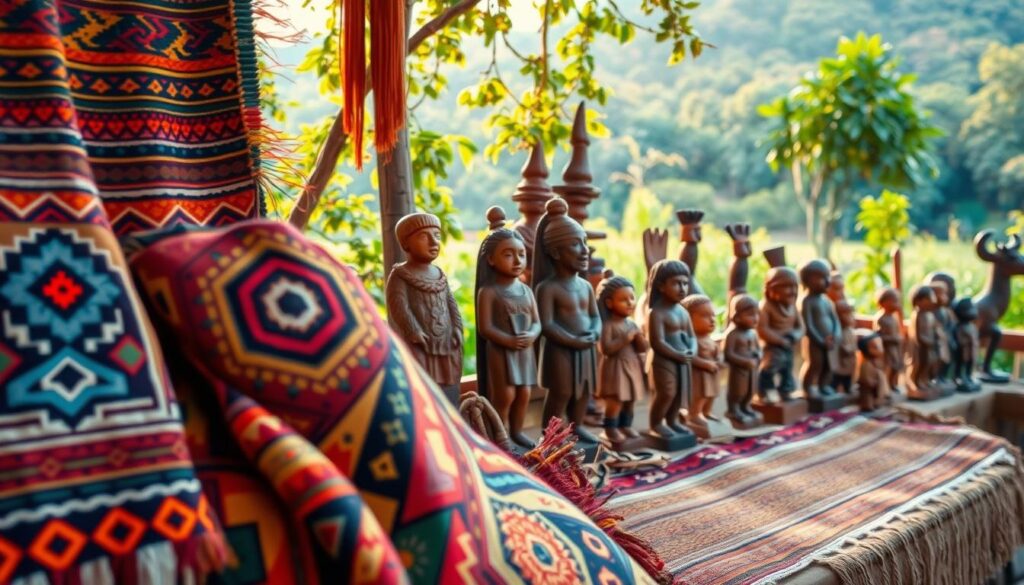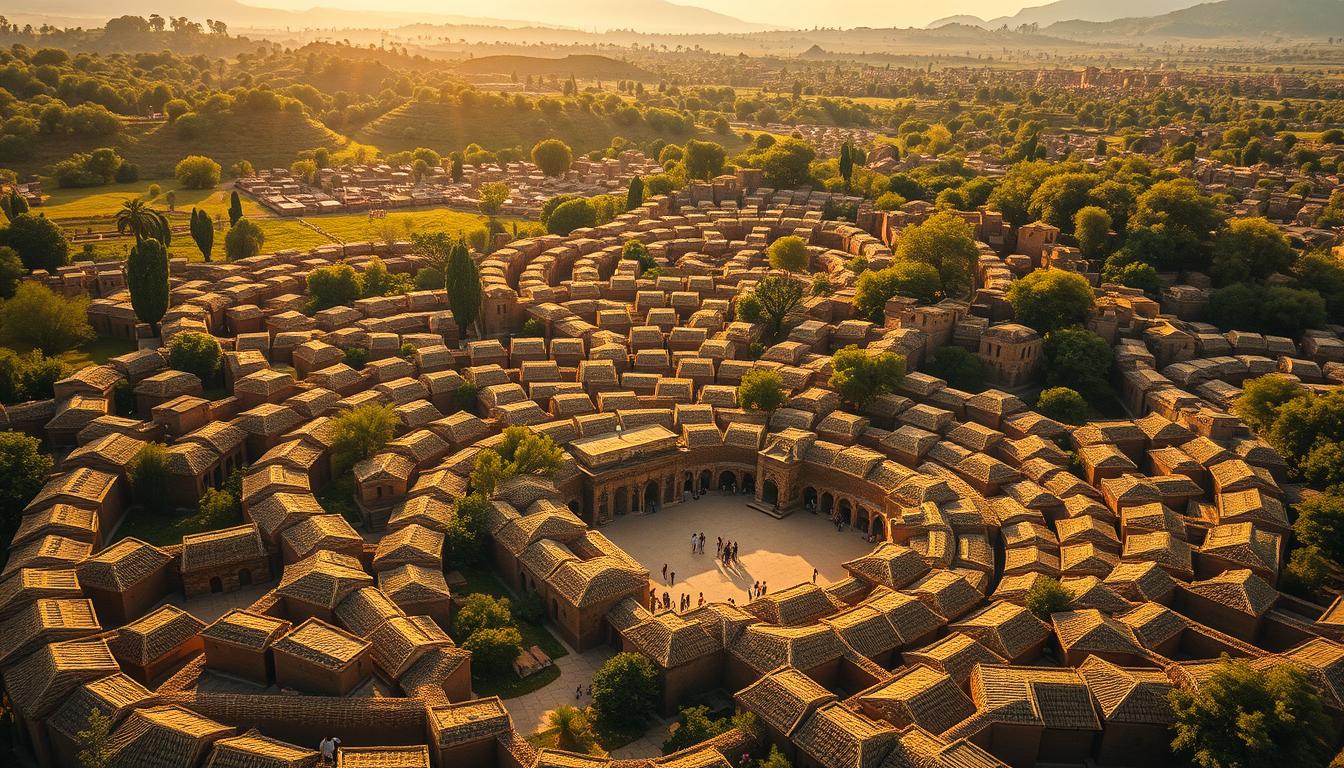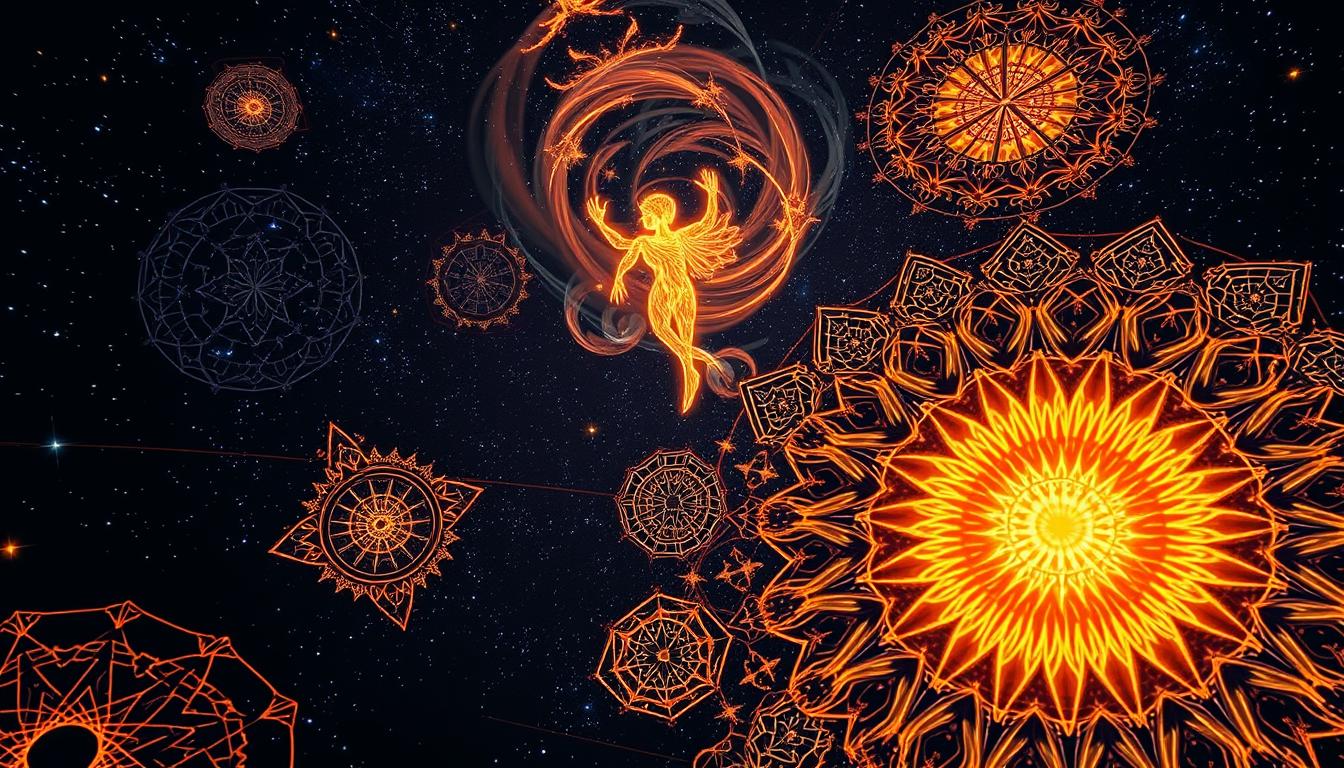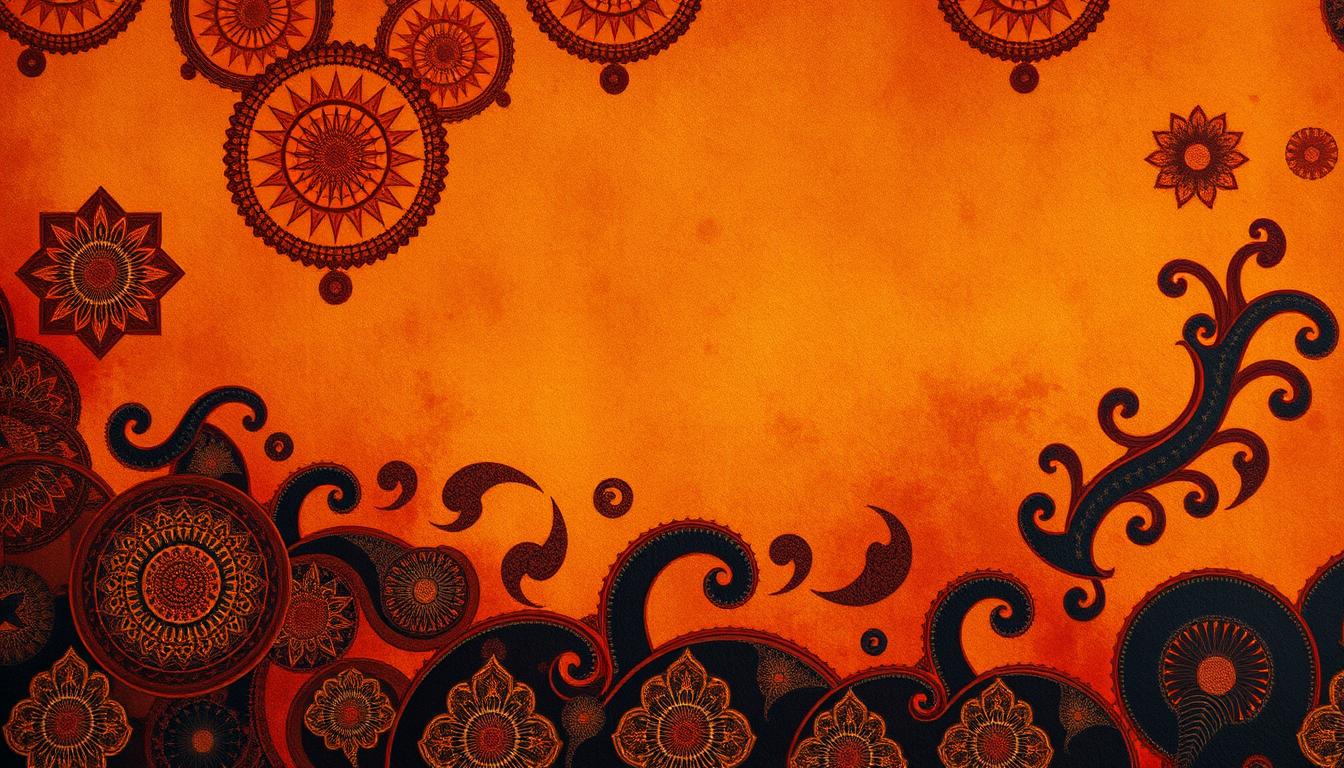Indigenous crafts are more than just art. They’re a way for communities around the world to showcase their heritage and identity. Lately, there’s been a big move to bring these traditional methods back, mixing them with new styles. One key part of this revival is using fractal design, a pattern that matches the complex shapes in nature.
By adding fractals to their work, indigenous artists give their crafts a fresh look. This also helps their art get noticed and valued in today’s art world. With fractals, these crafts connect deeper with their cultural roots. They also keep these important art forms alive and well.
The Intersection of Art and Culture
Indigenous art is key to showing the identity of a culture, linking deeply with community histories and traditions. It’s important to know the different traditional art forms to fully enjoy the stories they tell. Each indigenous art style uses unique techniques and shows a deep bond with the land, spiritual beliefs, and the wisdom of ancestors.
Understanding Indigenous Art Forms
Indigenous art includes many mediums and practices, passed down through generations. The bright colors, detailed patterns, and symbols share stories vital to both artists and their communities. Techniques like weaving, carving, and painting showcase the artists’ skills and the cultural importance of each piece. Truly getting the meaning of these art forms helps us understand the cultural identity they stand for.
Significance of Cultural Heritage
Keeping cultural heritage alive is crucial for keeping the stories and identities of indigenous peoples. Art acts as a link between the past and now, and helps share knowledge. By preserving these art forms, communities build a sense of belonging and strength. This bond to heritage makes cultural identity richer and raises awareness and respect among more people.

What Are Fractals?
Fractals are complicated shapes found throughout nature. They repeat similar patterns at different sizes. This shows an amazing link between math and our world. The study of fractals helps us see patterns in nature more clearly. It reveals a key feature: self-similarity. Self-similarity means patterns keep the same shape no matter the scale.
Exploring Fractal Patterns in Nature
Nature is full of fractals. Look at tree branches or the edges of coastlines. Natural patterns show a blend of order and randomness, matching fractal design. These patterns are not just pretty. They play a role in how ecosystems work. Studying them helps us understand how different forms of life survive together.
The Mathematical Foundations of Fractal Design
Fractals start with simple ideas like repeating steps and understanding shapes in new ways. These ideas lead to fascinating visual arts. Using patterns that repeat on different scales, artists find inspiration in nature. They mix art with math to create stunning works.
History of Indigenous Crafts
The rich history of indigenous crafts is a testament to the creativity of different cultures. It shows their identity and bond with the land. Over time, artisans have used traditional methods and materials. This has kept their skills alive. We will explore how these artisans work and the stories their crafts tell.
Traditional Techniques and Materials
Indigenous crafts stand out because they use nature. Artisans have passed down special techniques through the years. They use:
- Beadwork: Intricate designs that tell stories and symbolize cultural beliefs.
- Weaving: Making textiles from plant, animal, and mineral fibers, filled with deep meanings.
- Pottery: Creating items that celebrate heritage with unique shapes and patterns.
The skill shown in these crafts shows a deep love for nature. Each piece is special in the world of indigenous crafts.
The Role of Storytelling in Craftsmanship
Storytelling is key in linking past and present through art. Every crafted item carries a story that teaches and preserves culture. Through stories, artisans share values and keep their identities alive. This makes their art more meaningful and loved.
By adding storytelling to their work, artisans honor their history. Their goal is to inspire new generations to keep this tradition alive. This keeps indigenous crafts vibrant and important.
Revitalizing Indigenous Crafts with Modern Techniques
Modern techniques are changing the world of indigenous crafts. New technology lets artisans try out fresh ideas in creativity. Things like 3D printing and laser cutting introduce new possibilities. They allow for a precision that old methods couldn’t achieve. This mix of new tech with traditional ways is giving these old crafts new life. It makes sure these crafts grow while keeping their cultural heart.
The Impact of Technology on Craftsmanship
Artists are now using technology to make their work better. These new tools make creating easier and let artists try new things with different materials. More people can now access these tools, helping to keep these crafts alive. It also inspires young artists to connect with their cultural roots.
Blending Old and New: A Contemporary Approach
Artists are blending traditional and modern ways in their art. They mix old craftsmanship with new design ideas, creating unique pieces. This approach honors cultural heritage while making art that speaks to today. It’s a way to celebrate where we come from and where we’re going with our creative expression.
Utilizing Fractal Design in Traditional Indigenous Crafts
Today’s indigenous artists find beauty in fractal patterns for their crafts. They blend these complex designs into their art beautifully. This mix of old and new shows how fractals are deeply tied to cultural heritage.
Case Studies of Modern Indigenous Artists
Many indigenous artists are now using fractal styles in their work. They apply fractals to make their crafts look more complex. These designs help tell stories about their culture. For example:
- Artist A makes amazing textiles with fractal themes. They link nature’s designs to traditional stories.
- Artist B works with digital media to make fractal patterns. This shows the blend of old art and new ways.
- Artist C combines woodworking with fractals. This offers a fresh view on indigenous identity through art you can touch.
Fractals as a Reflection of Indigenous Identity
For indigenous cultures, fractal patterns mean a lot. They’re not just pretty but also connect deeply with identity in art. These designs remind us of nature and community values. They link artists to their roots strongly. Using fractals opens up discussions about cultural identity. This leads to a deeper appreciation of the deep connections in indigenous crafts. These artworks talk across the ages, keeping the conversation going strong.
Bridging the Gap: Art and Sustainable Practices
Using sustainable practices in indigenous crafts saves resources and keeps cultural values alive. Artisans are turning to eco-friendly materials, reducing their environmental impact. This approach meets the growing demand for green products and showcases artisans’ skills in an environmentally friendly way.
Eco-friendly Materials in Artisan Crafts
Artisans are choosing materials that are kind to the planet. They often use:
- Natural fibers like cotton and hemp
- Wood that’s been recycled or reclaimed
- Dyes made from plants
These eco-friendly choices support both our planet and cultural heritage. By focusing on natural resources, artisans make sure their crafts help the environment and honor tradition. This dedication not only makes their work more genuine but also attracts people interested in eco-friendly products.
Promoting Sustainable Tourism through Crafting
Indigenous crafts also encourage responsible tourism, attracting visitors seeking genuine cultural experiences. Through workshops and demos, artisans offer a deep dive into their craft. This lets tourists understand and respect the art and its environmental ethics. They learn about:
- The deep meaning behind each item
- How materials are ethically gathered
- The expert skill required
This connection boosts the local economy and promotes sustainable travel. Highlighting local crafts helps the economy and keeps traditions alive for the next generation.
Community Involvement and Collaboration
Community involvement is key to bringing back indigenous crafts. Artists join art collectives to work together and grow. These groups provide a space where they can share resources and keep their culture alive.
The Role of Art Collectives
Art collectives are where indigenous artists come together. They help one another, learning and growing together. These collectives organize workshops and events to make indigenous crafts more known.
Empowering Indigenous Artists
Supporting artists is essential. By working together, they get help with training and funding. This support not only boosts their creativity but also keeps their traditions alive. It brings new life to old practices and helps them create new art.
The Global Influence of Indigenous Fractal Art
Indigenous fractal art is now recognized worldwide. It brings art that touches people from different cultures. Artists use these platforms to share their culture’s stories and intricate patterns.
This exposure is critical. It allows us to see their unique heritage through their art. It also creates a space for sharing and discussing different cultures.
Exhibitions and Showcases Around the World
Important shows, like the Venice Biennale and the Sydney International Art Festival, include indigenous artists. This puts their art in the spotlight globally. These exhibitions show the deep link between math and culture through fractal patterns.
Such recognition brings global attention to these artists. It also celebrates the complexity and beauty of their work.
- Highlighting the craftsmanship involved in traditional practices
- Celebrating the narratives behind indigenous creations
- Creating dialogues among various cultural art forms
International Recognition of Indigenous Techniques
Recognizing these indigenous techniques worldwide is crucial. It helps ensure these practices are preserved and continue. By entering global art discussions, artists share their viewpoints and connect with others.
This recognition brings respect and appreciation for their cultural and artistic expressions. It enriches the global art community, making it more diverse and interconnected.
Challenges Facing Indigenous Crafts Today
Indigenous crafts are up against many hurdles today. They struggle with keeping their techniques and culture alive. The modern world, with its global reach, often clashes with these local art forms. This puts traditional ways at risk. Understanding and tackling these problems is key to keeping indigenous crafts going.
Preservation of Techniques and Culture
Keeping a culture alive greatly depends on passing down artistic skills. Indigenous crafts are in danger as expert artisans become scarce. Also, communities lose their connection to their own traditions. Things like city living and the pursuit of different careers pull younger folks away. They might leave behind their ancestral crafts. Saving these precious cultural treasures means both locals and outsiders need to work together.
The Impact of Globalization on Local Art Forms
Globalization changes local art by pushing uniformity and turning unique works into commodities. This can water down or misrepresent traditional art. Plus, with everything mass-produced, there’s a worry about cultural appropriation. Sometimes, indigenous art is borrowed without proper credit or respect. This erodes the true value of local art. A careful balance must be struck to share art worldwide while guarding its origins.
The Future of Fractal Design in Indigenous Crafts
Emerging artisans are the future of crafts, delving into fractal design with fresh approaches. They bring new life to indigenous crafts, blending them with modern techniques. This evolution in art encourages creative freedom and innovation.
Innovative Directions for Future Artisans
Artisans in the future will mix old indigenous methods with new styles. This will create exciting and diverse works. They may use:
- Digital tools for fractal-patterned crafts.
- Eco-friendly materials for sustainability.
- Technology to connect with more people, like online galleries.
Education and the Next Generation of Artists
Artist education is key to developing new talent. Programs that offer guidance and training help blend old and new ways. These programs should have:
- Workshops on traditional crafting.
- Group projects for sharing ideas.
- Resources for trying out new designs.
Investing in education and mentoring helps fractal design in crafts to grow. This prepares artists to respect their roots while exploring new artistic avenues.
Conclusion
In our journey, we looked at how fractal design and indigenous crafts come together. We saw the beauty in complex patterns and their role in connecting old traditions with new art forms. By using fractals, crafters showcase their heritage in a modern way, gaining more respect for their culture.
The article gave a detailed look at indigenous crafts and the power of merging old methods with new ideas. This mix not only makes the art look better but also helps keep cultures alive. It ensures these precious traditions stay vibrant in our fast-changing world.
Looking ahead, it’s the teamwork between tradition and technology that will keep indigenous crafts alive. As digital tools become more common, they offer fresh ways for artists to express their roots. This will help keep the beautiful diversity of indigenous art flourishing for future generations.



